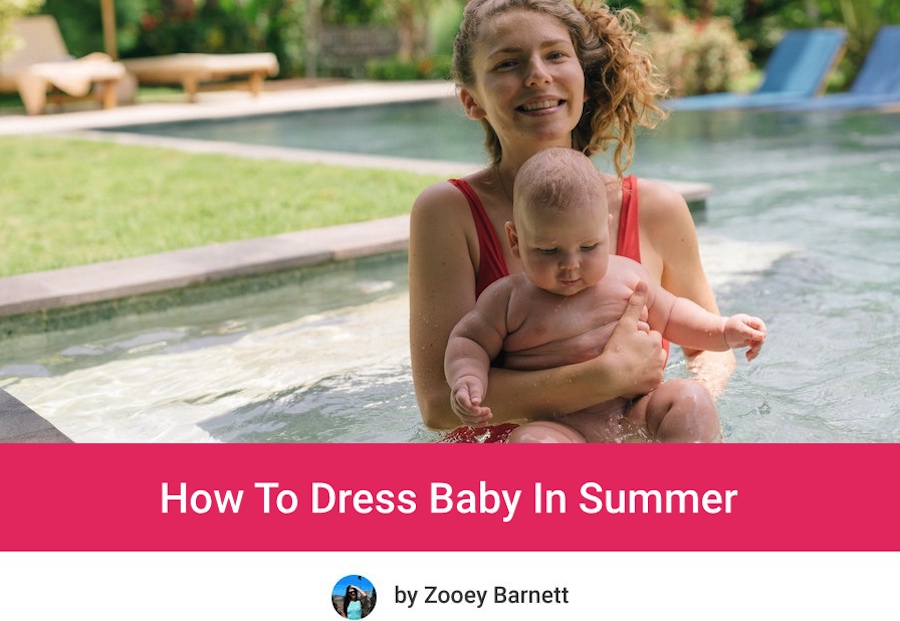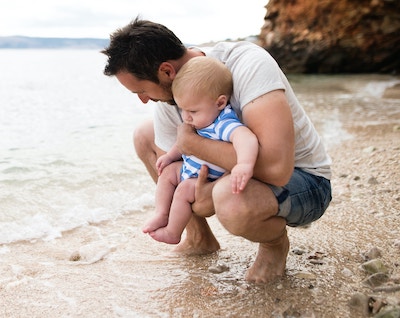
Did you know that it takes a newborn longer to cool down than older children or adults? While many parents worry about their infant being too cold in the winter, don’t forget to consider how to keep your baby cool during the summer, too.
The good news is that it’s not very complicated to avoid overheating; the first thing to look at are baby clothes. This post is all about how to dress a newborn in summer months to avoid overheating and keep baby comfortable, even in the hottest summer months.
This article is not a substitute for medical advice or consultation.
How To Dress Baby In Summer During The Day – Outside
Just as you want to keep baby safe in the winter and cover their feet with warm socks or booties, it’s important to consider how to dress your newborn in the heat, too. This isn’t only about the number of layers you dress a newborn in, but also the kind of fabric you choose for baby’s clothes, too.
Reach for natural, breathable fabrics, such as cotton and muslin over polyester or heavy denim items. Make sure items are comfortable and not too tight.

How To Dress Baby In Summer During The Day – At Home
So, what should a newborn wear? For a newborn in summer – when staying at home- I say go light. You can always add another layer, if you think they are too cool.
Typically, baby’s feet don’t need socks if it’s over 78°F (or a baby hat, for that matter). When they are awake and active, they can be in a diaper and simple, relaxed romper or onesie and shorts or loose, lightweight pants.
What Should I Dress My Baby In On A Hot Summer Night?
For bedtime (or naps) your little one can wear one layer under a light (0.5 or 1 TOG) sleep sack.
If it’s very warm, consider having them wear only a diaper and wrap them in the swaddle blanket with their arms out (of course – no loose bedding in the crib!)
Pay attention to adequate air flow – a fan might be a good idea to direct toward their sleeping area, even if you have the A/C running.
I have also prepared article about the best sleep sacks for summer – made from lightweight and airy fabrics, to prevent sweating and overheating.

Extra Tips For Dressing A Newborn Baby Safely For Hot Weather
Choose thin, breathable swaddle blankets – you can even find mesh ones, if your newborn needs the feel of a swaddle without the added warmth.
Pay attention to the TOG rating of your sleep sacks. Some or perfect of autumn or winter months, but I would reach for 0.5 TOG or 1.0 TOG-rated items during the summer.
If using reusable diapers, don’t snap them on too tight – allow for plenty of air flow between the legs. Some moms choose to go diaper-free in the hottest summer months, or temporarily switch to disposable diapers, just to help them stay cooler.
If you don’t have A/C, try putting your baby in a damp (not soaking wet) onesie. This will help them to keep a little cooler.
Newborn Baby Temperature
Research shows that a newborn baby’s temperature is actually naturally lower than an adults. Whereas an adult might naturally be at at 98 or 99°F, a newborn should be expected to be around 97.5°F.
Finally, newborns don’t have the ability to regulate their own temperatures like adults do, they don’t sweat as easily to bring their body temperature down. So they need breathable clothes and preventative measures to avoid overheating1.

Effect Of Hot Weather On Babies
Some of the summertime heat risks2 that infants face include:
- Overheating
- Developing heat rash
- Dehydration
Finally, studies have shown that overheating contributes to risk of SIDS (sudden infant death syndrome) therefore, the American Academy of Pediatrics recommends ensuring your newborn doesn’t overheat while they are sleeping: remove infant hats and use a gentle fan over their sleeping area. Opt for cooler, not overly warm fabrics for baby’s sleepwear3.
Sweating is the body’s means of cooling down. Since infants do not sweat easily, if you see that your newborn is sweaty, remove some layers of clothing.
If your baby feels hot to the touch, help them cool off by patting them down with a cool (not frigid cold) cloth and dressing them in just a onesie, not too many layers.

How Do I Know If My Baby Is Too Hot?
Early signs that baby is too hot:
- Fussy or crying
- Older babies may pull at their clothing, but a newborn likely will only squirm
- Feels hot to the touch at the back or bellyIf you notice any of these signs, I recommend you remove a layer of clothing and bring them to a cooler location, if outdoors
Later signs that a newborn is too hot:
- Sweating
- Red face
- Vomiting
- Heat rash (prickly red spots on their body)
Remember that overheating is dangerous for babies4.
Extra Tips For Keeping Baby Cool During Summer Months
- Ensure your stroller has a functioning stroller shade.
- Add a screen over car window where baby’s carseat is placed (this may also provide UV protection).
- Regularly check the stroller temperature, and do not leave your newborn napping in the stroller outdoors in the summer.
- Take breaks from babywearing. Cuddling with mom is cozy – but can easily get sweaty, too. Let both of you breathe. And of course choose a baby carrier that is designed for hot weather (lightweight and made from breathable material) – to keep both of you from sweating.
- Wear a large sunhat when baby wearing, which can also reduce baby’s sun exposure.
How To Dress Newborn Baby In Summer Safely – FAQ
It’s advised that baby be dressed in one layer more than adults for the weather, however, in hot summer months, there is some flexibility to this rule.

What Should Newborn Wear In The Summer?
If it feels very warm to you, remember that babies are at an increased risk of overheating because they cannot easily regulate their body temperatures. Help them stay cool by removing additional layers in hot weather.
Lightweight onesies are the best options for babies when it’s hot outside.
How Many Layers Should Newborn Baby Wear In The Summer?
How to dress a newborn in summer depends on the temperature at your location, and if you have air conditioning or not.
If you’re planning to stroll through a cool shopping mall, dressing your newborn in thin layers that you can remove as necessary is a good idea.
Also, if your little one loves the feeling of an extra layer when in the carseat or stroller, pay attention to the fabric and thickness you choose.

How Often Should I Change My Newborn’s Clothes During Hot Day?
Adjust your baby’s wardrobe as often as needed to keep baby cool in changing temperatures. Usually, you don’t need to change their entire outfit, just remove a layer.
This can be taking off a shirt or light sweater and having them wear only a onesie, or packing a few extra onesies in their diaper bag.
What Fabrics Are Best For Newborns On Summer Days?
Natural fabrics have been found to help baby stay cool better than synthetic material, such as polyester or blends.
Organic cotton has been tested as more breathable than regular cotton, so reach for organic cotton onesies or muslin material in summer.
Can I Use Sunscreen On My Newborn Baby?
A newborn baby’s skin is too sensitive for sunscreen. Instead, you should limit a newborn’s sun exposure and note the UV index when spending time outside with a newborn5:
- Dress a newborn in a sun hat, or pull a shade over them when in a stroller.
- If you are babywearing, wear a wide sun-hat as a sun protection for you both.
- Have your ilttle one sleep in the shade, under a wide umbrella or indoors.
- Be careful when taking a newborn to the beach where there are little or no natural forms of shade: come with your own umbrella or tent to keep your baby out of direct sunlight.
- Though sunglasses are cute, a baby doesn’t need them – a sunhat is best.
When a baby reaches 6 months old, they can begin using infant-safe sunscreen (NOT chemical sunscreens, these are not appropriate for the sensitive skin of a young child)6. Check out my previous post about the best safe, chemical-free sunscreens for babies to find out which products are best for infants.

Can Newborns Wear Long Sleeves In Summer?
Yes! Long-sleeves offer a natural sun protection for baby’s arms. Choose a loose-fitting onesie, so there is plenty of airflow around the arms.
What is most important thing here is choosing light, breathable fabrics, even if the items are long-sleeved.
How To Dress Baby In AC?
Wondering about dressing a newborn in summer when you have A/C in your home?
Since air conditioning can set a comfortable temperature in your home, including baby’s room, dressing your baby for the indoor temperature (not the predicted outdoor weather) is recommended.
This means you can use lightweight sleep sacks or regular infant sleepwear without stress. Above all, pay attention to your baby’s comfort, and if in doubt, feel their back or core to see if they are too hot or too cold.
- Newborns
Dress a newborn in a onesie and a swaddle or a sleep sack.
- Younger babies (3 – 6 months)
Sleep sacks are ideal for babies this age, since they can likely roll at this stage. Dress them in a lightweight onesie underneath.
- Older babies (6 – 12 months)
If your location is very warm, dress your baby in only a diaper, or a diaper and a t-shirt or simple onesie. Sleep sacks are not necessary during warm months for daytime naps.
How Should I Dress My Baby For 80 Degrees Outside?
Dress your baby in light layers during summer months. Avoiding heavy or synthetic clothing. Cotton or muslin garments are ideal.
Choose baby clothing that is breathable and not too tight. You can remove layers to keep baby cool, but add a light shirt or simple covering if you enter a shop or building with powerful air conditioning.
How Do I Swaddle My Baby In Hot Weather?
You can wrap up your baby even in the hot summer months, just pay attention to what they are wearing underneath it.
In warmer weather, you might want to put them in only in a diaper and a simple, cotton onesie.
If the weather is hot, make sure to dress a newborn in only a diaper, then wrap in a breathable cotton or muslin swaddle.
You may want to check your newborn more frequently in hot weather, feel his or her neck to see if he or she is too warm – remember, your baby should not sweat.
It’s okay to wrap the swaddle with your little one’s arms out, but don’t open the swaddle so much it becomes an item of dangerous bedding, either.
The purpose of this article is informative. It’s not a substitute for professional medical advice or medical care. Remember: safety first! Consult your doctor/pediatrician in case of any doubts. The author of this article does not accept any responsibility for any liability, loss or risk, personal or otherwise, incurred as a consequence, directly or indirectly, from any information or advice contained here.
Resources:
https://pepalondon.com/
https://www.metropediatrics.com/
https://who.int/
https://aap.org/

